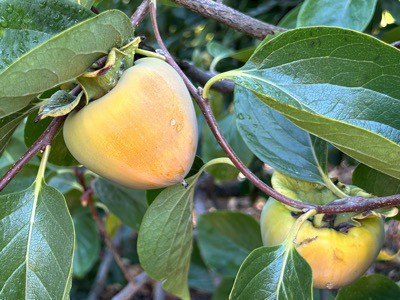
Final event of the year focuses on fall planting, composting and more

Hachiya persimmons ripen on a tree in the Fair Oaks Horticulture Center's orchard. The center will be fully open to the public one last time this year, on Wednesday, Oct. 11, from 9 a.m. to noon. Kathy Morrison
Fall is for planting – but what? And how? (And what can you do with all those autumn leaves?)
Find out during a special midweek Open Garden hosted by the UC Cooperative Extension Master Gardeners of Sacramento County.
From 9 a.m. to noon Wednesday, Oct. 11, the Sacramento County master gardeners will open the gates of Fair Oaks Horticulture Center. Admission and parking are free.
This event is your last chance to get their expert hands-on advice in person this year.
“Join Sacramento’s UC Master Gardeners for the final open garden event of 2023,” say the master gardeners. “You will get locally-relevant insights on caring for your garden at the end of the season’s bounty – preparation for 2024. See colorful foliage and late-season blooms like cherry-red pineapple sage against lime green leaves. Feel free to bring your curiosity and questions. Pictures of problem pests or plants, or samples in an enclosed bag or jar, can be helpful.”
Two special presentations will start at 10 a.m.: “Composting at Home” (under the Kiwi Arbor) and “Fall Planting” (in the Water-Efficient Landscape garden).
Among the highlights Wednesday:
Water-Efficient Landscape: Fall clean-up to manage pests and adding bulbs for spring blooms.
Compost: Turning and sifting finished compost. Kids love finding and caring for red wigglers.
Berries: Pruning and amending the soil for the proper pH.
Herbs: See cool-season bloomers such as hyssop, chrysanthemums, dianthus and sages.
Vegetables: Planting cover crops and cool-season veggies to sustain Sacramento year-round.
Orchard: Late-season harvesting, mulching and preparations for frost protection.
Vineyard: Noting color changes that could mean more than normal fall changes.
Also, get a copy of the master gardeners’ 2024 Garden Guide and Calendar ($12 cash or check). These make great gifts, too.
The Fair Oaks Horticulture Center is located at 11549 Fair Oaks Blvd., Fair Oaks, in Fair Oaks Park.
Details: https://sacmg.ucanr.edu/.
Comments
0 comments have been posted.Sacramento Digs Gardening to your inbox.
Sites We Like
Garden Checklist for week of July 21
Your garden needs you!
* Keep your vegetable garden watered, mulched and weeded. Water before 8 a.m. to reduce the chance of fungal infection and to conserve moisture.
* Feed vegetable plants bone meal, rock phosphate or other fertilizers high in phosphate to stimulate more blooms and fruiting. (But wait until daily high temperatures drop out of the 100s.)
* Don’t let tomatoes wilt or dry out completely. Give tomatoes a deep watering two to three times a week.
* Harvest vegetables promptly to encourage plants to produce more. Squash especially tends to grow rapidly in hot weather. Keep an eye on zucchini.
* Pinch back chrysanthemums for bushy plants and more flowers in September.
* Remove spent flowers from roses, daylilies and other bloomers as they finish flowering.
* Pinch off blooms from basil so the plant will grow more leaves.
* Cut back lavender after flowering to promote a second bloom.
* It's not too late to add a splash of color. Plant petunias, snapdragons, zinnias and marigolds.
* From seed, plant corn, pumpkins, radishes, winter squash and sunflowers.